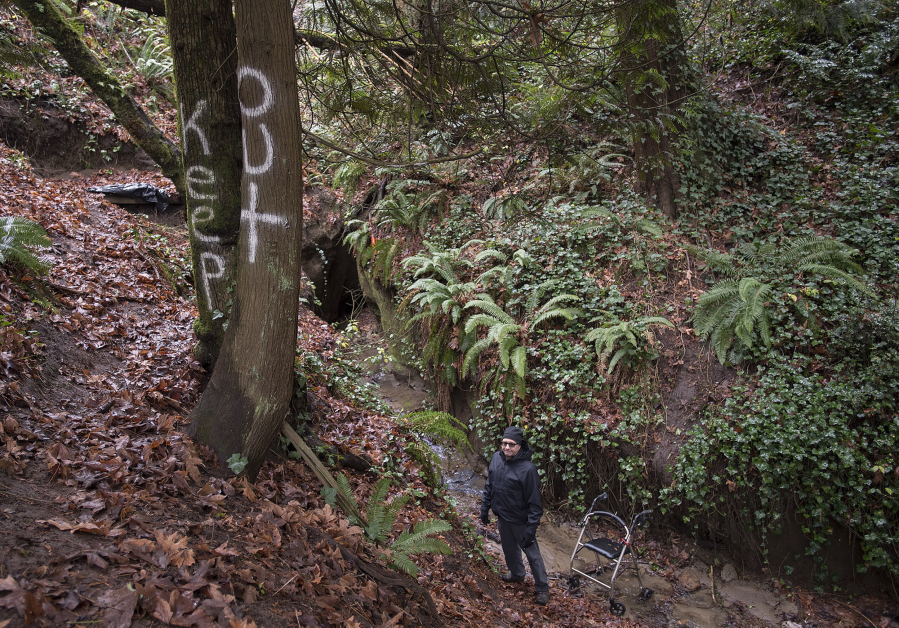Peter Bracchi enjoys hiking off the beaten path at Vancouver’s Arnold Park. His brief explorations often take him through a steep ravine, where a tributary feeds into Burnt Bridge Creek, near the northeast edge of the park.
Bracchi, 60, said he likes seeing the beautiful foliage as it changes throughout the seasons.
“It’s a whole little world you can jump out into from our neighborhood,” the West Minnehaha resident said.
However, what he doesn’t like seeing are illegal homeless encampments scattered throughout the wooded area and the litter that’s left behind.
Bracchi moved to the neighborhood in February and began noticing tents and debris in the spring during his daily walks through the park.
People have been camping in the area, he said, in spite of no-camping signs and clear instructions to vacate the park before dark. Many campers move on, but some belongings and plenty of trash remain. Bracchi said one tent in particular sat at the top of the ravine for more than six months. A cleanup crew recently responded and cleared it out, he said.
Campers dug away at the side of the hill for a make-shift shelter — a leftover platform and tarp remain as evidence.
“That’s when you start erosion and start altering things in mother nature,” Bracchi said.
When The Columbian visited the park with Bracchi on Dec. 2, there was a walker, pie tin, clothing, battery, bucket and trash in the ravine. Trees spray-painted with “Keep out” warn off park users.
Bracchi said it was much worse before cleanup crews swept through the area and that he went “ballistic” when he saw all of the debris.
“There’s probably crap elsewhere; this is just what I know about,” he said.
He has been hounding Vancouver Public Works, 311 — the non-emergency number for Clark Regional Emergency Services Agency — and Vancouver police for months. Part of the problem is that he isn’t sure who he should be contacting, he said.
Police are often called out to these problem areas by the city’s operations greenways division to assist with posting at campsites, contacting unlawful campers and cleaning up the sites, Vancouver police Officer Tyler Chavers said in an email. It’s become a weekly task, he added.
“As long as there have been homeless folks in Vancouver, there have been camps all along the Burnt Bridge Creek Trail system from the Andresen corridor all the way up into the county along the Ellen Davis Trail,” Chavers said.
Bracchi said he’s encouraged by the city’s latest response at the park.
“I’m so happy they cleaned it up. There was so much garbage in there. That’s what really yanked my chain,” he said. “It was so sickening and heartbreaking to see that.”
An inmate work crew led by David Lott, an offender crew chief with Clark County Corrections, comes out to the trail system four times a week and is very familiar with the issues at Arnold Park. The crew holds a contract with the city.
Lott said illegal camping is a constant problem along the Burnt Bridge Creek Trail. He has been dealing with many of the same folks over the years. Some are felons and sex offenders, he said, but the majority struggle with substance abuse. Lott said he’s yet to come across a family or individual camping there who has simply fallen on hard times.
“You got to have some sympathy for these people, but some people are out here by choice,” he said.
The crew follows city protocol, which includes posting notices for campers — which gives them anywhere between 48 to 72 hours to vacate the area, sometimes longer given the circumstances — taking photos of the campsite and notifying code enforcement and police.
“The city doesn’t use a hard and fast rule for the notice. There’s no magic to the 72 hours from the city’s position,” said Jonathan Young, civil division chief with the Vancouver City Attorney’s Office. “What we are looking for is evidence the property in question isn’t momentarily left by a person but is actually abandoned.”
He said notices are posted based on a need to clean up an area, primarily due to a safety or health reason.
City employees are asked to laminate and post the notices in a conspicuous location and make contact with people who are nearby to see if they need help moving their belongings.
“We recognize that just because it doesn’t look to have tremendous dollar value doesn’t mean it doesn’t have value to them,” Young said. “The city sees working with this homeless population and working with its partners as a high priority.”
Lott said anything left behind that appears to be trash is thrown out. Personal property with intrinsic value is turned over to the city.
The city and county have become more conscientious of their efforts after a federal judge in Tacoma found that county work crews violated the constitutional rights of at least a half-dozen homeless people when they tossed out their belongings during clean-ups from 2012 to 2014.
“Part of our dilemma is what may be trash to me, may not be trash to them,” Lott said.
The other problem is that if campers move a reasonable distance away from the posted notice, the process starts over, he said.
Lott estimates his crew hauls out hundreds of tons of debris from the trail system per year.
“It’s an expense to the city and taxpayers,” he said.
Lott’s crew was also at the park Dec. 2 clearing out blackberry bushes and brush from the top of the ravine, in part because opening up the area seems to be effective in deterring people from camping, he said.
In addition to cleaning up the ravine, crews in late November cleared out debris left at an area south of 41st Circle near 15th Avenue, west of Arnold Park, Public Works Neighborhood Liaison Loretta Callahan said in an email.
Cleanup efforts have been ramping up the past year, Chavers added, as more citizens have become aware of the city’s homeless issues “and as more folks using the park and trail system began calling in tents and tarps they could see in the wooded areas.
“In many places across the city, this issue has gotten better, while in others it persists,” he said.
This is what frustrates Bracchi.
He said he would like to see the city put a good, working plan in place by the spring.
“There’s got to somehow be a public process consensus,” Bracchi said. “We can offer them help, but if they don’t want it, then what can we do?”




